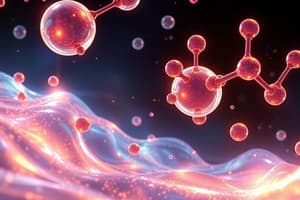Podcast
Questions and Answers
Explain how the interplay between molecular size/shape and intermolecular forces affects the boiling point of organic compounds. Provide an example to illustrate your explanation.
Explain how the interplay between molecular size/shape and intermolecular forces affects the boiling point of organic compounds. Provide an example to illustrate your explanation.
Larger molecules with greater surface area exhibit stronger London dispersion forces, leading to higher boiling points. For example, butane (larger molecule) has a higher boiling point than ethane (smaller molecule) due to increased dispersion forces.
Consider two substances: one exhibiting dipole-dipole interactions and the other exhibiting only London dispersion forces. What additional information would you need to determine which substance has a higher boiling point?
Consider two substances: one exhibiting dipole-dipole interactions and the other exhibiting only London dispersion forces. What additional information would you need to determine which substance has a higher boiling point?
To determine which has a higher boiling point you would need to know the relative strength of the dipole-dipole interactions and the molecular size/surface area to estimate the magnitude of the London dispersion forces. The substance with overall stronger IMFs will have a higher boiling point.
Hydrogen bonding is crucial for many biological processes. Describe how hydrogen bonding contributes to the unique properties of water and its significance for life.
Hydrogen bonding is crucial for many biological processes. Describe how hydrogen bonding contributes to the unique properties of water and its significance for life.
Hydrogen bonding in water leads to high surface tension, high specific heat, and anomalous density (ice floats). These properties allow aquatic life to survive under ice, stabilize temperatures, and facilitate nutrient transport.
A liquid with a high vapor pressure is placed in a closed container. Explain the relationship between its intermolecular forces and the rate at which it evaporates.
A liquid with a high vapor pressure is placed in a closed container. Explain the relationship between its intermolecular forces and the rate at which it evaporates.
How does the presence of ion-dipole forces affect the solubility of ionic compounds in polar solvents? Provide an example.
How does the presence of ion-dipole forces affect the solubility of ionic compounds in polar solvents? Provide an example.
Flashcards
Intermolecular Forces (IMFs)
Intermolecular Forces (IMFs)
Attractive or repulsive forces between molecules.
Dispersion Forces
Dispersion Forces
Present in all molecules; result from temporary fluctuations in electron distribution. Strength increases with molecular size and surface area.
Dipole-Dipole Forces
Dipole-Dipole Forces
Occur between polar molecules due to uneven electron distribution, creating a permanent dipole moment.
Hydrogen Bonding
Hydrogen Bonding
Signup and view all the flashcards
Ion-Dipole Forces
Ion-Dipole Forces
Signup and view all the flashcards
Study Notes
- Intermolecular forces (IMFs) are attractive or repulsive forces between molecules
Types of Intermolecular Forces
- Dispersion forces (also known as London dispersion forces) are present in all molecules and result from temporary fluctuations in electron distribution
- The strength of dispersion forces increases with the size and shape of the molecule (i.e., molar mass and surface area)
- Dipole-dipole forces occur between polar molecules, which have a permanent dipole moment due to uneven electron distribution
- Hydrogen bonding is a particularly strong type of dipole-dipole force that occurs when hydrogen is bonded to highly electronegative atoms (N, O, or F)
- Ion-dipole forces occur between ions and polar molecules
IMFs and Physical Properties
- IMFs influence various physical properties of substances, such as boiling point, melting point, viscosity, surface tension, and vapor pressure
- Substances with strong IMFs tend to have higher boiling points and melting points because more energy is required to overcome these attractions.
- Viscosity, the resistance of a liquid to flow, is higher for substances with stronger IMFs because the molecules are more attracted to each other
- Surface tension, the energy required to increase the surface area of a liquid, is also higher for substances with stronger IMFs
- Vapor pressure, the pressure exerted by a vapor in equilibrium with its liquid or solid phase, is lower for substances with stronger IMFs because fewer molecules have enough energy to escape into the gas phase
Phase Transitions
- Phase transitions, such as melting, boiling, sublimation, and condensation, involve changes in the strength of IMFs
- Energy must be added to overcome IMFs during melting, boiling, and sublimation (endothermic processes)
- Energy is released when IMFs are formed during freezing, condensation, and deposition (exothermic processes)
Ranking IMFs
- Generally, ion-dipole forces are the strongest, followed by hydrogen bonding, dipole-dipole forces, and dispersion forces
- However, the strength of dispersion forces can become significant in large molecules, sometimes surpassing dipole-dipole interactions
Examples
- Water (H2O) exhibits hydrogen bonding, which contributes to its relatively high boiling point compared to other molecules of similar size
- Methane (CH4) only has dispersion forces, resulting in a low boiling point
- Ethanol (CH3CH2OH) exhibits both hydrogen bonding and dispersion forces, leading to a higher boiling point than ethane (CH3CH3), which only has dispersion forces
Studying That Suits You
Use AI to generate personalized quizzes and flashcards to suit your learning preferences.




